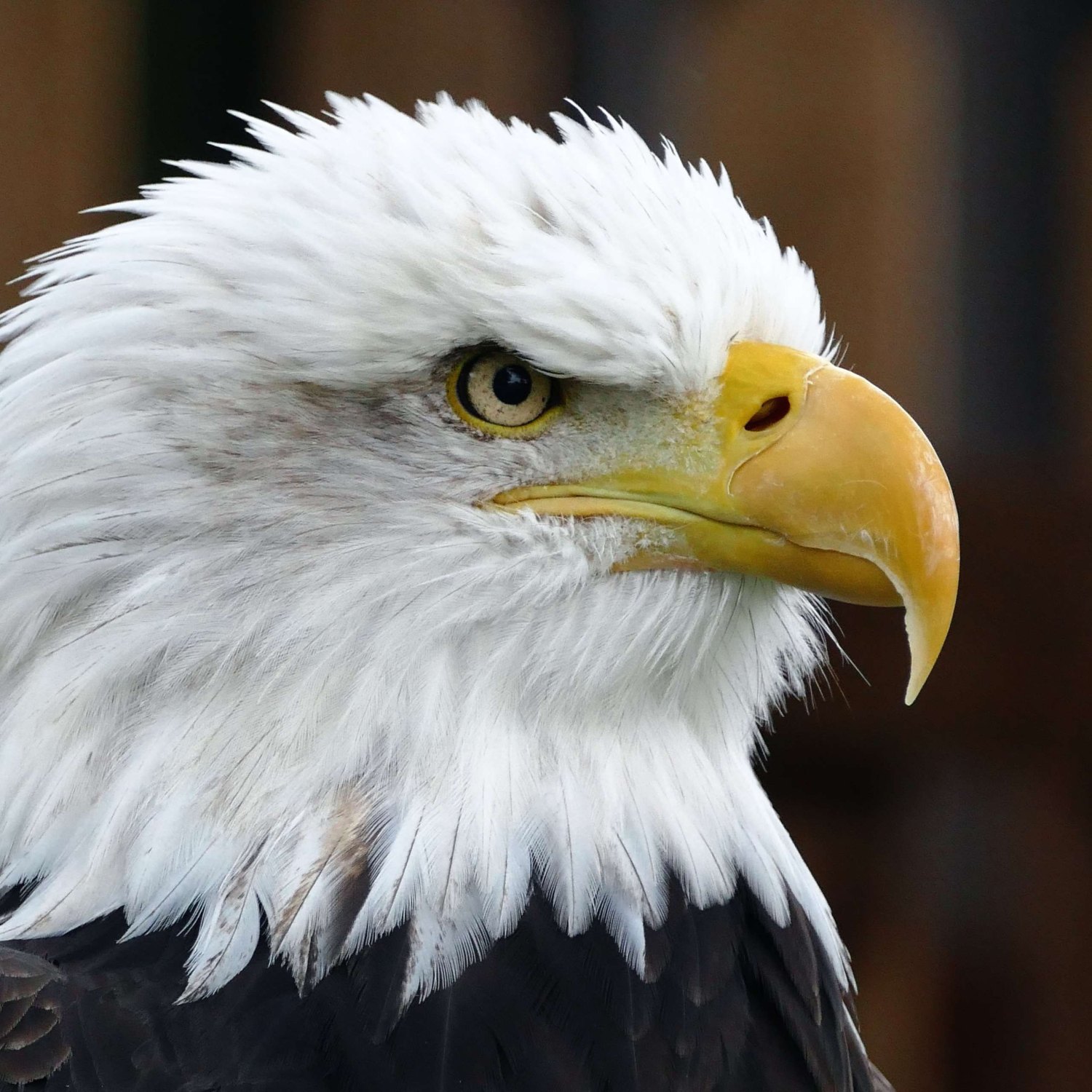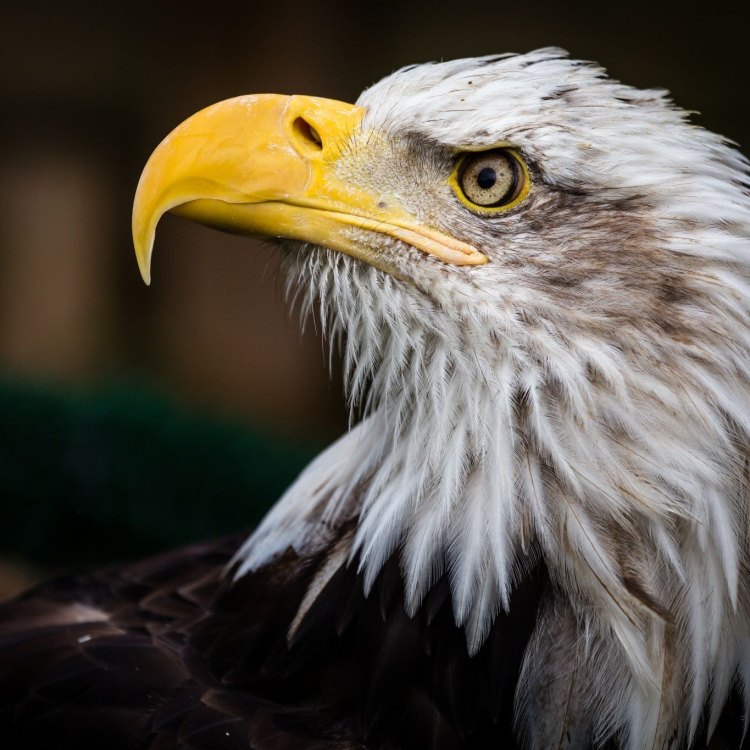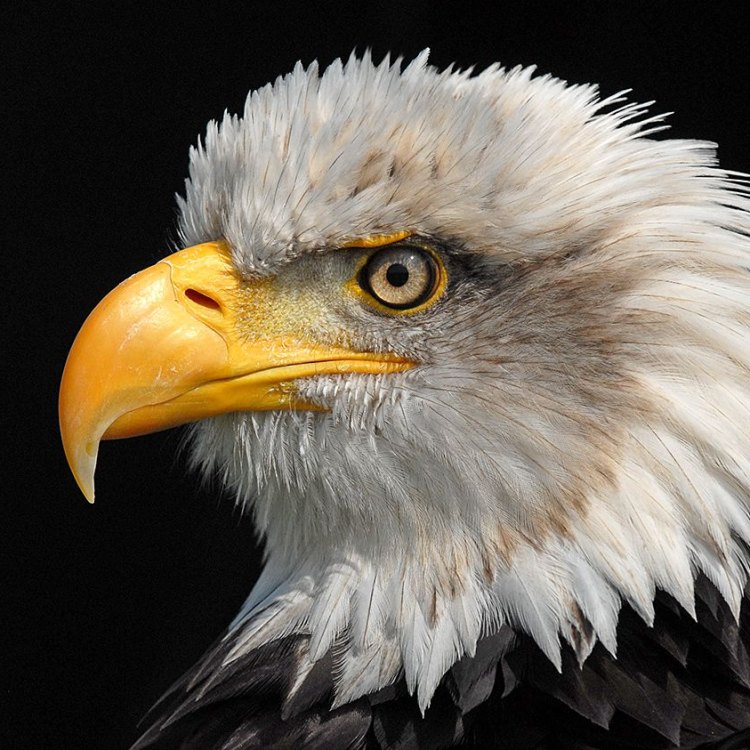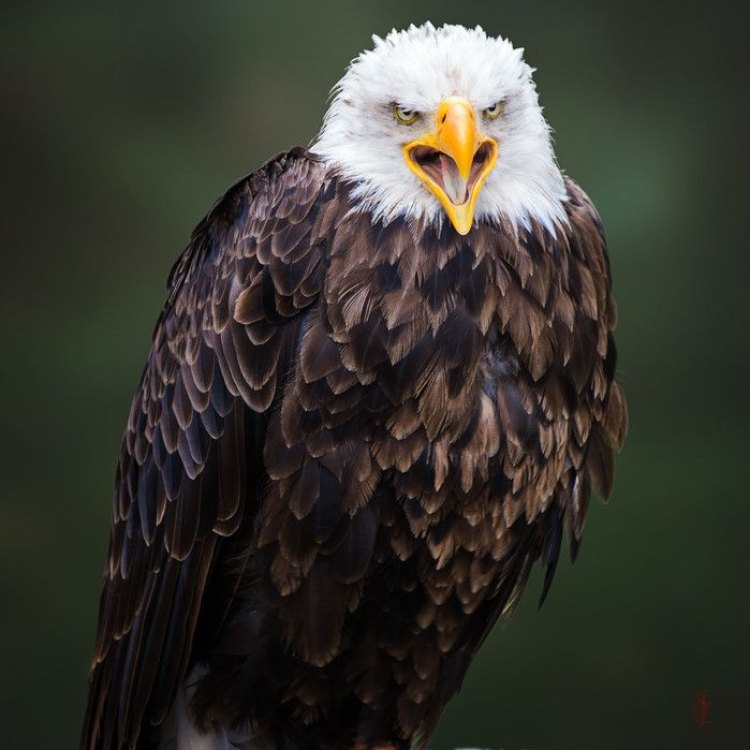
Eagle
70 - 90 cm (27 - 35 in)
Did you know that the majestic Eagle, a member of the Accipitridae family, can be found soaring through the skies in North America? With a wingspan of 70-90 cm and a powerfully built body, these birds are truly a sight to behold. Keep an eye out for these impressive creatures on your next outdoor adventure! #Eagles #NorthAmerica #Accipitridae #BirdWatching #NatureLovers
Animal Details Summary:
Common Name: Golden Eagle
Kingdom: Animalia
Habitat: Mountains, cliffs, open and semi-open landscapes
The Majestic Golden Eagle: The King of the Skies
The eagle, a magnificent bird that commands attention and admiration, is the undisputed monarch of the skies. Among its different species, the golden eagle, scientifically known as Aquila chrysaetos, stands out for its striking appearance and impressive abilities. This majestic bird, also known as the king of the skies, is a symbol of power, freedom, and loyalty. Today, we will take a closer look at this remarkable bird of prey and learn about its unique characteristics, habitat, and behaviors Eagle.Majestic Appearance
The golden eagle is a large and powerfully built bird, stretching up to 70-90 cm (27-35 in) in length and boasting an impressive wingspan of 180-224 cm (71-88 in). Its body is covered in dark brown feathers, with golden feathers on its head and neck. These golden feathers, which give the bird its name, are more prominent in mature eagles.With sharp, hooked beaks and long, strong legs, the golden eagle is designed for hunting and survival. Its eyes are also specially adapted for hunting, with excellent vision that enables it to spot prey from a great distance.
Habitat and Distribution
Golden eagles can be found in diverse habitats across North America, Europe, Asia, and northern Africa. They are most commonly found in mountainous, forested regions, but they can also be found in open and semi-open landscapes such as prairies and grasslands.In the United States, golden eagles can be found throughout much of the country, with the exception of Hawaii. They are also found in significantly large populations in Alaska, making it the state with the highest golden eagle population in the country Eurasian Jay.
Carnivorous Diet
As a bird of prey, the golden eagle primarily feeds on other animals. Its hunting prowess is impressive, and it has been known to take down prey much larger than itself, including mammals such as deer and pronghorn. Its diet also includes smaller animals such as rabbits, squirrels, and groundhogs. Golden eagles are opportunistic hunters, meaning they will eat whatever prey is available, including carrion.They hunt by soaring over their territory, using their incredible eyesight to locate prey on the ground. Once they spot their target, they will dive with precision and speed, using their sharp talons to grab and kill their prey.
Powerful Flight
Golden eagles are renowned for their incredible flying abilities, with graceful and powerful soaring being their primary means of travel. Their broad wings and light bodies allow them to effortlessly glide through the air without expending much energy.They are also known for their impressive speed, reaching up to 200 miles per hour when diving after prey. This speed, coupled with their sharp talons, makes them formidable hunters in the skies.
Family Bonds
Golden eagles are not just solitary birds; they form strong bonds with their mates and offspring. During courtship, male and female eagles perform impressive aerial displays, diving and soaring together in unison.Once they have selected a mate, golden eagles will often mate for life, staying together until one of them dies. They also work together to build and maintain their nests, which are large structures made of twigs and branches, lined with grass and feathers.
The female lays two eggs, and both parents take turns incubating them until they hatch. Once the eggs hatch, both parents work to provide food for their young. Young eagles will stay with their parents for about two years until they are ready to leave the nest and start their own families.
Majestic but Endangered
While the golden eagle is a symbol of strength and power, it is also a vulnerable species. In the United States, golden eagles are protected under the Bald and Golden Eagle Protection Act, as well as other state and federal laws. These protections are crucial as they are listed as a threatened species in some parts of their range.One of the major threats to golden eagle populations is human activities, such as habitat destruction, collisions with man-made structures, and illegal shooting. These eagles are also highly sensitive to disturbance, and constant human presence near their nesting sites can cause them to abandon their nests.
Importance in Nature
Golden eagles play a crucial role in maintaining balance in their ecosystems. They are apex predators, meaning they are at the top of the food chain. As such, they help control the population of their prey, preventing certain species from becoming too abundant.In addition to their ecological importance, the golden eagle also holds cultural and symbolic significance in many indigenous cultures. They have been revered as symbols of strength, courage, and wisdom for centuries, and their presence in the natural world is crucial to the cultural identity of many communities.
Conclusion
In conclusion, the golden eagle is a magnificent bird that deserves our admiration and respect. Its impressive appearance and abilities, as well as its vital role in nature and significance in different cultures, make it a truly remarkable and awe-inspiring species.As we continue to learn about and appreciate these majestic birds, it is essential to also understand the importance of protecting them and their habitats. By understanding and valuing these creatures, we can ensure their existence for generations to come, and the golden eagle can continue to reign as the king of the skies.

Eagle
Animal Details Eagle - Scientific Name: Aquila chrysaetos
- Category: Animals E
- Scientific Name: Aquila chrysaetos
- Common Name: Golden Eagle
- Kingdom: Animalia
- Phylum: Chordata
- Class: Aves
- Order: Accipitriformes
- Family: Accipitridae
- Habitat: Mountains, cliffs, open and semi-open landscapes
- Feeding Method: Carnivore
- Geographical Distribution: North America, Europe, Asia, and northern Africa
- Country of Origin: United States
- Location: North America
- Animal Coloration: Dark brown with golden feathers on the head and neck
- Body Shape: Large and powerfully built
- Length: 70 - 90 cm (27 - 35 in)

Golden Eagle
- Adult Size: Wingspan: 1.8 - 2.34 meters (6 - 7.7 ft)
- Average Lifespan: Up to 30 years in the wild
- Reproduction: Sexual
- Reproductive Behavior: Monogamous
- Sound or Call: High-pitched whistling or bugling calls
- Migration Pattern: Partial migratory
- Social Groups: Solitary or in pairs
- Behavior: Strong and agile fliers, excellent hunters
- Threats: Habitat loss, poisoning, illegal shooting
- Conservation Status: Least Concern
- Impact on Ecosystem: Top predator in their habitat
- Human Use: Historically used for falconry
- Distinctive Features: Golden feathers on the head and neck, large size
- Interesting Facts: Golden Eagles can reach great speeds during flight, up to 240 kilometers per hour (150 mph)
- Predator: No natural predators

Aquila chrysaetos
The Majestic Eagle: A Symbol of Strength and Power
The eagle, a magnificent bird of prey, has captured the imagination of humans for centuries. With its sharp vision, powerful talons, and majestic appearance, it is no wonder that the eagle is often associated with strength, power, and freedom. Of all the different species of eagles, the Golden Eagle stands out as one of the most striking and fascinating. Let us dive into the unique and interesting features of this impressive bird PeaceOfAnimals.Com.The Golden Eagle (Aquila chrysaetos) is found in the Northern Hemisphere, inhabiting mountainous and open areas across Europe, Asia, North America, and parts of Africa. As one of the largest and most widely distributed species of eagle, it is a top predator in its ecosystem. Let us explore the various aspects that make this bird truly exceptional.
Size, Lifespan, and Reproduction
The Golden Eagle's size is a remarkable feature that immediately catches the eye. When fully grown, they can attain a wingspan of 1.8-2.34 meters (6-7.7 ft), making them one of the largest birds of prey in the world. They also have an impressive weight of around 3 Eurasian Collared Dove.5-7 kg (7.7-15.5 lbs). This size and weight make them dominant predators in their environment, capable of taking down big prey such as deer and mountain goats.In the wild, Golden Eagles can live up to 30 years. However, their lifespan can be greatly reduced by human disturbances, such as habitat loss, poisoning, and illegal shooting. These threats are a severe concern, leading to a decline in their population in certain areas. As a result, the International Union for Conservation of Nature (IUCN) has listed the species as "Least Concern" on its Red List of Threatened Species.
Golden Eagles reach sexual maturity at around four to five years of age. They are monogamous, meaning they mate for life. Once they find a partner, they stay together and are fiercely protective of their territory. The breeding season for Golden Eagles is from January to August, and they form nesting pairs in remote areas, building large nests made of sticks and lined with soft materials like grass and animal fur. The female lays one to four eggs, and both parents take turns incubating them for about 40-45 days. Once hatched, the young eagles, called eaglets, grow rapidly and leave the nest after about 70-80 days.
Behavior, Communication, and Social Structure
The Golden Eagle is a solitary bird, and it typically lives alone or in pairs, rarely in groups. They are territorial and defend their range against intruders, especially during the breeding season. Their behavior is characterized by their incredible flying abilities, making them a symbol of power and freedom. They are agile fliers, capable of reaching speeds of up to 240 kilometers per hour (150 mph) during their dives. They also possess exceptional vision, which enables them to spot their prey from high altitudes.While these birds are mostly silent, they do have a distinct call. They make high-pitched whistling or bugling calls, often used to maintain communication with their mates or young eagles. Males have a higher-pitched voice than females, and their calls can be heard from a considerable distance.
Despite their solitary nature, Golden Eagles have been observed engaging in behavior that some scientists call "playing." They have been seen performing aerobatic flights, chasing each other, and performing other aerial displays. This behavior is believed to be a way for the birds to strengthen their bond with their mates and young eagles.
Predator, Habitat, and Ecosystem Impact
Unlike many other animals, the Golden Eagle does not have a natural predator. They sit at the top of their food chain, hunting and feeding on a wide range of prey, such as rabbits, hares, ground squirrels, and sometimes small deer. Their strong and muscular legs and their sharp talons make them perfect for capturing and holding their prey.Golden Eagles prefer remote, mountainous areas with rocky cliffs and open spaces. They can also be found nesting in areas with significant prey populations, such as grasslands and shrublands. However, due to human activities like logging, road construction, and urbanization, the Golden Eagle's habitat is under threat, negatively impacting their population and their prey's population.
As top predators, Golden Eagles play a crucial role in maintaining balance and diversity in their ecosystem. By hunting and controlling prey populations, they regulate the distribution of resources, influencing other animals' behavior and limiting the spread of diseases.
Human Use and Distinction
Throughout history, humans have had an interesting relationship with Golden Eagles. In ancient times, they were revered by many cultures, considered symbols of strength and courage. They were also used for falconry, a hunting technique where trained birds of prey were used to catch wild animals. Today, falconry is still practiced in some parts of the world, and the Golden Eagle remains a highly sought-after bird for this purpose.Apart from their role in falconry, Golden Eagles have also been depicted in pop culture and literature. From ancient Greek mythology to modern-day logos, they have become a symbol of power and freedom, with their image often associated with national emblems and flags.
One of the most distinctive features of the Golden Eagle is its stunning appearance. They have dark brown feathers covering their bodies, with a golden coloration on their necks, heads, and sometimes legs. This distinctive feature is what sets them apart from other eagle species and gives them their name. With their large size and striking coloration, the Golden Eagle is truly a unique and magnificent bird.
Conclusion
The Golden Eagle is undoubtedly a remarkable creature, with its size, strength, and beauty captivating our attention. However, despite their impressive abilities and unique features, they are facing numerous threats that are endangering their population. It is up to us, as responsible humans, to take measures to protect these amazing birds and preserve their habitats. By doing so, we can ensure that future generations will continue to marvel at the majesty of the Golden Eagle, a symbol of strength, power, and freedom.

The Majestic Golden Eagle: The King of the Skies
Disclaimer: The content provided is for informational purposes only. We cannot guarantee the accuracy of the information on this page 100%. All information provided here may change without prior notice.












